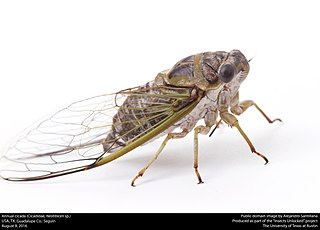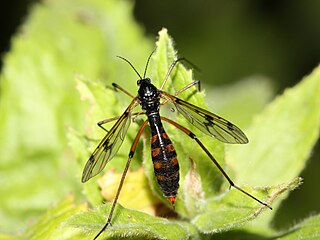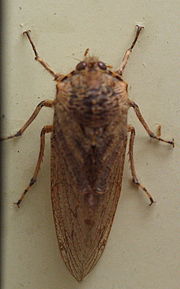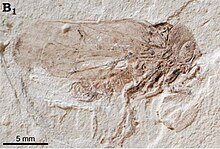
Cicadidae, the true cicadas, is one of two families of cicadas, containing almost all living cicada species with more than 3,200 species worldwide.

Bittacidae is a family of scorpionflies commonly called hangingflies or hanging scorpionflies.

The Ptychopteridae, phantom crane flies, are a small family of nematocerous Diptera. Superficially similar in appearance to other "tipuloid" families, they lack the ocelli of the Trichoceridae, the five-branched radial vein of the Tanyderidae, and the two anal veins that reach the wing margins of the Tipulidae. They are usually allied with the Tanyderidae based on similarities of the mesonotal suture, this group being called the Ptychopteromorpha.

Anaxyelidae is a family of incense cedar wood wasps in the order Hymenoptera. It contains only one living genus, Syntexis, which has only a single species, native to Western North America. Fossils of the family extend back to the Middle Jurassic, belonging to over a dozen extinct genera, with a particularly high diversity during the Early Cretaceous. Syntexis lay eggs in the sapwood of conifers, preferring recently burnt wood.

Osmylidae are a small family of winged insects of the net-winged insect order Neuroptera. The osmylids, also called lance lacewings, stream lacewings or giant lacewings, are found all over the world except North and Central America. There are around 225 extant species.

The Ommatidae are a family of beetles in the suborder Archostemata. The Ommatidae are considered the extant beetle family that has most ancestral characteristics. There are only seven extant species, confined to Australia and South America. However, the geographical distribution was much wider during the Mesozoic spanning across Eurasia and Australia, suggesting that they were widespread on Pangea. So far, over 26 extinct genera containing over 170 species of these beetles have been described. Three extant genera have been assigned to this family: Omma,Tetraphalerus and Beutelius. The family is considered to be a subfamily of Cupedidae by some authors, but have been found to be more closely related to Micromalthidae in molecular phylogenies. A close relationship with Micromalthidae is supported by several morphological characters, including those of the mandibles and male genitalia. Due to their rarity, their ecology is obscure, it is likely that their larvae feed on deadwood.
The Haifanggou Formation, also known as the Jiulongshan Formation, is a fossil-bearing rock deposit located near Daohugou village of Ningcheng County, in Inner Mongolia, northeastern China.

Palaeontinidae, commonly known as giant cicadas, is an extinct family of cicadomorphs. They existed from the Late Triassic to the Early Cretaceous. Despite being described as "giant cicadas", they are not particularly closely related to true cicadas. The family contains around 30 to 40 genera and around a hundred species.

Artematopodidae is a family of soft-bodied plant beetles in the superfamily Elateroidea. They are mostly found in understory forest foliage. The life history of the group is obscure, larvae of the genera Eurypogon and Macropogon likely feed on moss, while the larvae of Artematopus have been fed insect remains. The oldest fossils of the family date to the Middle Jurassic.
The Progonocimicidae are an extinct family of true bugs in the suborder Coleorrhyncha. Progonocimicidae fossils have been found in Europe, Asia, Australia, and South America.
2018 in paleoentomology is a list of new fossil insect taxa that were described during the year 2018, as well as other significant discoveries and events related to paleoentomology that were scheduled to occur during the year.

Sinoalidae is an extinct family of froghoppers known from the late Middle Jurassic to the early Late Cretaceous of Asia. They are one of two main Mesozoic families of froghoppers, alongside Procercopidae, unlike Procercopidae, Sinoalidae is thought to be an extinct side branch and not ancestral to modern froghoppers. Sinoalids have a temporally disjunct distribution being only known from the late Middle Jurassic (Callovian) Yanliao Biota of Inner Mongolia and the early Late Cretaceous (Cenomanian) aged Burmese amber of Myanmar, separated by over 60 million years. The family is "recognized by its tegmen with the costal area and clavus commonly more sclerotized and punctate than the remaining part, and its hind tibia with two rows of lateral spines"

Archijassidae is an extinct family of leafhoppers known from the Late Triassic to the early Late Cretaceous. It is the oldest member of Membracoidea, and is considered ancestral to modern leafhoppers and treehoppers.

Procercopidae is an extinct family of froghoppers. They are known from the Early Jurassic to early Late Cretaceous of Eurasia. They are one of two main families of Mesozoic froghoppers alongside Sinoalidae. Procercopidae are considered to be the ancestral group from which modern froghoppers are derived.
Fulgoridiidae are an extinct family of Mesozoic planthoppers. They are the earliest group of planthoppers known, and appear to be a paraphyletic assemblage ancestral to living planthoppers. The majority of known members of the family lived in the Jurassic period, though the group also includes one Cretaceous taxon. All currently known species are from Eurasia.
Praeaulacidae is an extinct family of Mesozoic parasitic wasps in the suborder Evanioidea. It among the earliest known families of the group and is characterised by more complete wing venation in comparison to other members of the suborder. It has been found that Othniodellithidae is nested within Praeaulacidae via cladistic analysis.
Lophioneurida is an extinct suborder of Thysanoptera, dating from the Carboniferous to the Cretaceous. It is likely paraphyletic, with modern thrips having evolved from members of the group.

Orthophlebiidae is an extinct family of scorpionflies known from the Triassic to Cretaceous, belonging to the superfamily Panorpoidea. The family is poorly defined and is probably paraphyletic, representing many primitive members of Panorpoidea with most species only known from isolated wings, and has such been considered a wastebasket taxon.
Liadopsyllidae is an extinct family of hemipteran insects belonging to Psylloidea ranging from the Early Jurassic to Upper Cretaceous. The family was named by Andrey Vasilyevich Martynov in 1926. They are the earliest known members of Psylloidea, with modern members of the group not known until the Paleogene, as such, they have been suggested to be a paraphyletic assemblage ancestral to modern psylloids. The family Malmopsyllidae has been subsumed into this family, but is considered distinct by some authors.
Geinitziidae is an extinct family of polyneopteran insects, known from the Permian to Cretaceous. They are currently considered to be members "Grylloblattida" a poorly defined group of extinct insects thought to be related to modern ice crawlers (Grylloblattidae). Other authors place them in the extinct order Reculida. Unlike modern ice crawlers, which are wingless, they had large wings, bearing a superficial resemblance to cockroaches, and are thought to have been day-active above ground predators.














